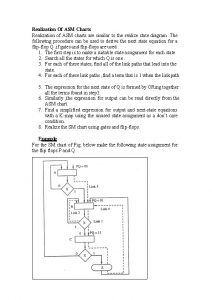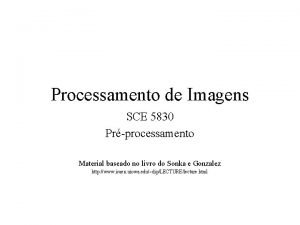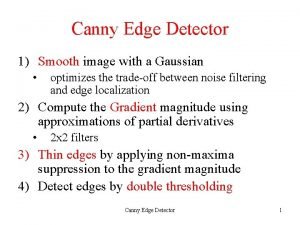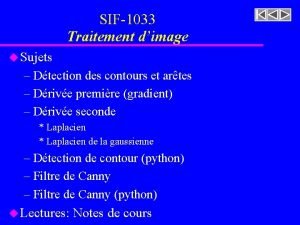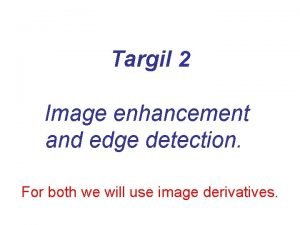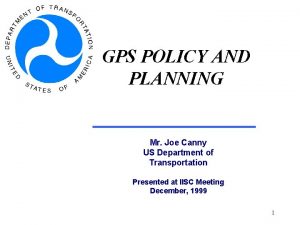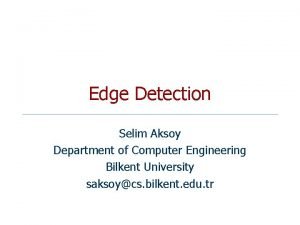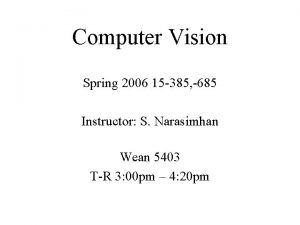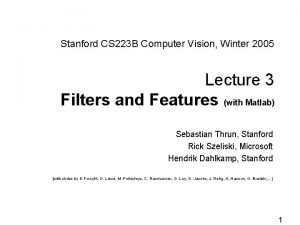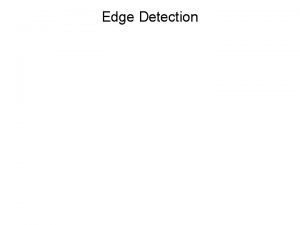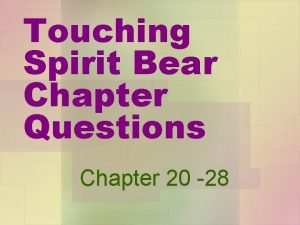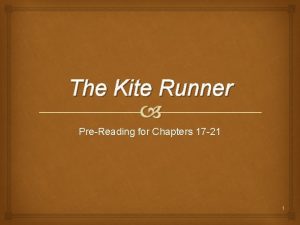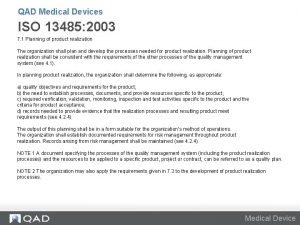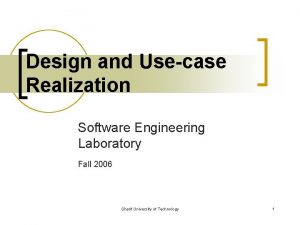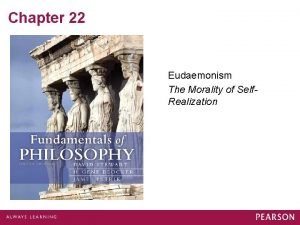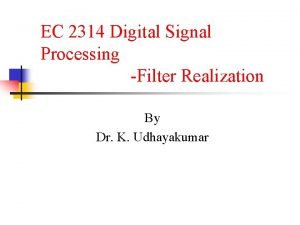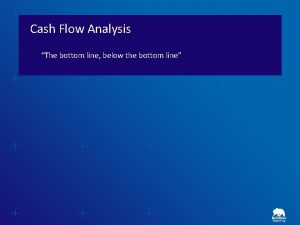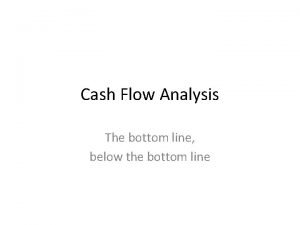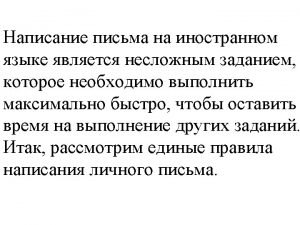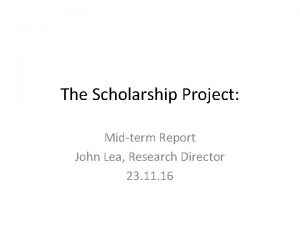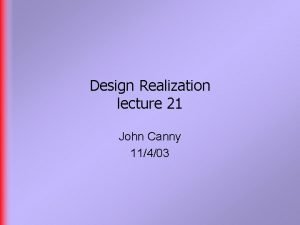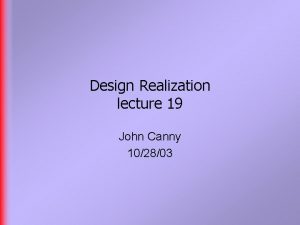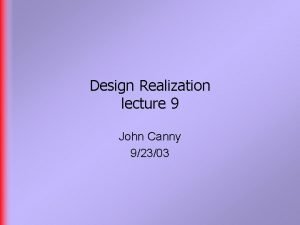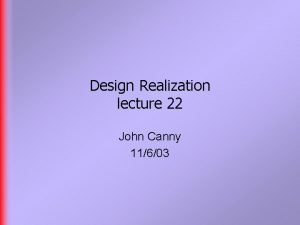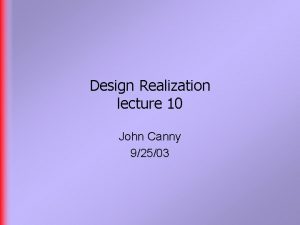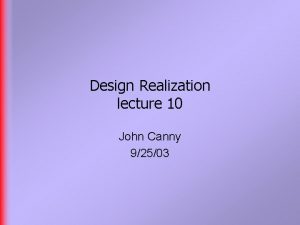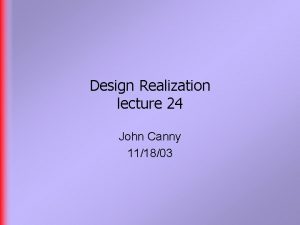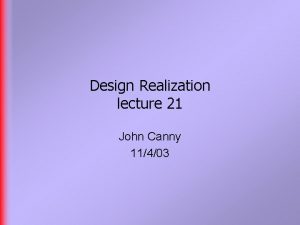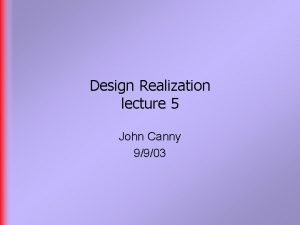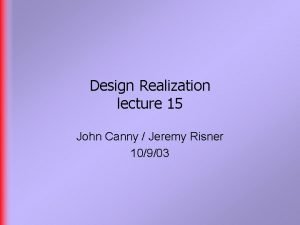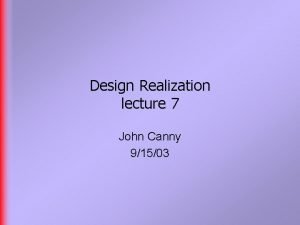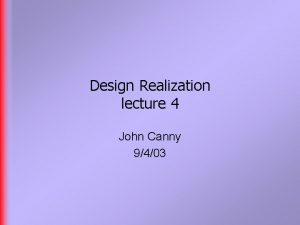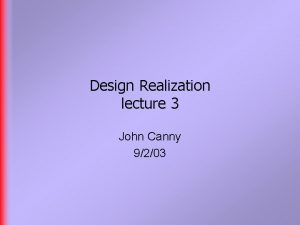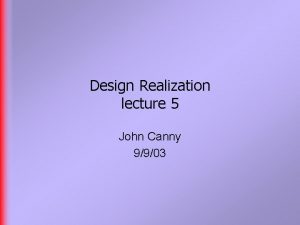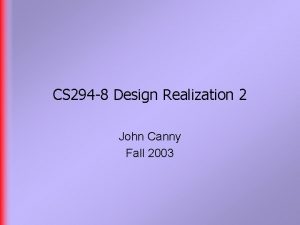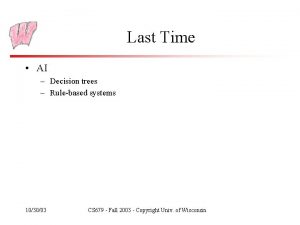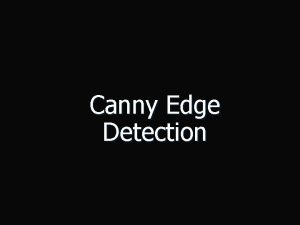Design Realization lecture 20 John Canny 103003 Last



































- Slides: 35

Design Realization lecture 20 John Canny 10/30/03

Last time § Real-time programming

This time § Mechanics – Physics and Motors

Review of physics § Newton’s law for translation: F=ma F in Newtons, m in kg, a in m/s 2. § Acceleration a = dv / dt § Kinetic energy E = ½ m v 2 E in Joules, m in kg, v in m/s.

Physics of translation § Momentum p = m v and so F = dp / dt § In the absence of force, momentum is conserved. § Momentum conservation implies energy conservation.

Physics of rotation § Rotation is more complex; Euler’s equation: T=I + x. I T (torque) in N-m, in radians/sec 2, I in kg-m 2, = d / dt § I is a 3 x 3 matrix, not necessarily diagonal. § If T = 0, then I = - x I which is usually non-zero. So is non-zero, changes with time, and the object wobbles.

Physics of rotation § Angular momentum is q = I § The rotation equation simplifies to T = dq / dt because dq/dt = I d /dt + d. I/dt = I + x I § So even though an object wobbles when there is no external force, the angular momentum is conserved: q = I

Physics of rotation § Kinetic energy of rotation is ½ T I § In the absence of external torque, kinetic energy of rotation is conserved. § But angular momentum conservation does not imply energy conservation.

Work § Work done by a force = F x (Joules) where x is the distance (m) through which the force acts. § Work done by a torque = T (Joules)

Power § Power is rate of doing work. § Power of a force = F v (Watts). § Power of a torque = T (Watts). § Power often expressed in horsepower = 746 Watts

Motors § Motors come in several flavors: § § § DC motors Stepper motors (AC) induction motors (AC) Single-phase motors (AC) Synchronous motors § The first two are highly controllable, and usually what you would use in an application. But we quickly review the others.

3 -phase AC § Three or four wires that carry the same voltage at 3 equally-spaced phases: § Single phase AC requires two wires (only 1/3 the current or power of 3 -phase).

AC induction Motors § Induction motors – simple, cheap, high-power, high torque, simplest are 3 -phase. § Speed up to 7200 rpm: speed ~ 7200 / # “poles” of the motor. § Induction motors are brushless (no contacts between moving and fixed parts). Hi reliability. § Efficiency high: 50 -95 %

Single-phase AC Motors § Single-phase (induction) motors – operate from normal AC current (one phase). Household appliances. § Single-phase motors use a variety of tricks to start, then transition to induction motor behavior. § Efficiency lower: 25 -60% § Often very low starting torque.

Synchronous AC Motors § Designed to turn in synchronization with the AC frequency. E. g. turntable motors. § Low to very high power. § Efficiency ? ?

DC Motors § DC motor types: § DC Brush motor § “DC” Brushless motor § Stepper motor

DC Brush Motors § A “commutator” brings current to the moving element (the rotor). § As the rotor moves, the polarity changes, which keeps the magnets pulling the right way. DEMO § Highly controllable, most common DC motor.

DC Brush Motors § At fixed load, speed of rotation is proportional to applied voltage. § Changing polarity reverses rotation. § To first order, torque is proportional to current. § Load curve: § Motors which approximate this ideal well are called DC servo motors.

DC Brushless Motors § Really an AC motor with electronic commutation. § Permanent magnet rotor, stator coils are controlled by electronic switching. DEMO § Speed can be controlled accurately by the electronics. § Torque is often constant over the speed range.

Stepper Motors § Sequence of (3 or more) poles is activated in turn, moving the stator in small “steps”. § Very low speed / high angular precision is possible without reduction gearing by using many rotor teeth. § Can also “microstep” by activating both coils at once.

Driving Stepper Motors § Note: signals to the stepper motor are binary, onoff values (not PWM). § In principle easy: activate poles as A B C D A… or A D C B A…Steps are fixed size, so no need to sense the angle! (open loop control).

Driving Stepper Motors § But in practice, acceleration and possibly jerk must be bounded, otherwise motor will not keep up and will start missing steps (causing position errors). § i. e. driver electronics must simulate inertia of the motor.

Stepper Motor example § § § § From Sherline CNC milling machine: Step angle: 1. 8° Voltage: 3. 2 V Holding torque: 0. 97 N-m Rotor inertia: 250 g-cm 2 Weight: 1. 32 lb (0. 6 Kg. ) Length: 2. 13" (54 mm) Power output = 3 W § Precision stepper motor: 0. 02° /step, 1 rpm, 3 W

DC Motor example § § § § § V = 12 volts Max Current = 4 A Max Power Out = 25 W Max efficiency = 74% Max speed = 3500 rpm Max torque = 1. 4 N-m Weight = 1. 4 lbs Forward or reverse (brushed) Many DC motors of all sizes available new and surplus for < $10

DC Motors – micro sizes § From Micromo: § Conventional (brush) DC motor: 6 mm x 15 mm § 13, 000 rpm § 0. 11 m Nm § Power 0. 15 W § V from 1. 5 to 4. 5 V

Brushless DC Motors § From Micromo: § Brushless DC motor: 16 mm x 28 mm § 65, 000 rpm § 50 m Nm § Power 11 W § V = 12 V

DC Motors – gearing § Gearing allows you to trade off speed vs. torque. § An n: 1 reduction gearing decreases speed by n, but increases torque by n. § Ratios from 10: 1 to many 1000 s : 1 are available in compact “gearheads” that attach to motors.

DC Motors – gearing § But gears cost efficiency (20% - 50%) § Gears decrease precision (due to backlash). § Reduction gear train is normally not backdriveable (can’t use for “force control”).

DC torque motors § Some high-end motors are available for direct drive servo or force applications (no gears). § They have low speed (a few rpm), high precision (with servo-ing), and moderate torque. § Typically have large diameter vs. length, and use rare-earth magnetic material. § Cost $100’s (but maybe less as surplus).

Sensors § Shaft encoders can be fitted to almost any DC motor. They provide position sensing. § Many motor families offer integrated encoders. § Strain gauges can be used to sense force directly. Or DC brush motor current can be used to estimate force.

Linear movement § There are several ways to produce linear movement from rotation: § Rotary to linear gearing:

Linear movement § Ball screws: low linear speed, good precision § Motor drives shaft, stages move (must be attached to linear bearing to stop from rotating).

Linear movement § Belt drive: attach moving stage to a toothed belt: § Used in inkjet printers and some large XY robots.

True Linear movement § § § § There are some true linear magnetic drives. BEI-Kimco voice coils: Up to 1” travel 100 lbf > 10 g acceleration 6 lbs weight 500 Hz corner frequency. § Used for precision vibration control.

Summary § AC motors are good for inexpensive high-power applications where fine control isnt needed. § DC motors provide a range of performance: § DC brush: versatile, “servo” motor, high speed, torque § DC brushless: speed/toque depend on electronics § Stepper: simple control signals, variable speed/accuracy without gearing, lower power § Direct-drive (torque) motors, expensive, lower torque § Linear actuation via drives, or voice coils.
 Asm chart
Asm chart Imagem de uma rampa fonte max pixel
Imagem de uma rampa fonte max pixel What is canny edge detection in image processing
What is canny edge detection in image processing Filtre laplacien
Filtre laplacien Targil
Targil Joe canny
Joe canny Canny
Canny Canny
Canny Canny sebastian
Canny sebastian Canny mask
Canny mask 01:640:244 lecture notes - lecture 15: plat, idah, farad
01:640:244 lecture notes - lecture 15: plat, idah, farad Randy pausch last lecture summary
Randy pausch last lecture summary Touching spirit bear chapter 20
Touching spirit bear chapter 20 What realization does amir come to in chapter 19
What realization does amir come to in chapter 19 Iso 13485 product realization
Iso 13485 product realization Use case realization example
Use case realization example Self realization aristotle
Self realization aristotle What is use case realization
What is use case realization Use case realization
Use case realization Signal processing filter
Signal processing filter Cash realization ratio
Cash realization ratio Cash realization ratio
Cash realization ratio Cognitive provides various channels for self-realization.
Cognitive provides various channels for self-realization. Concept to realization
Concept to realization Reinforcement lap lengths eurocodes
Reinforcement lap lengths eurocodes Elemen urban design
Elemen urban design Elements and principles of design ppt
Elements and principles of design ppt Lecture hall acoustics
Lecture hall acoustics Game design lecture
Game design lecture Computer aided drug design lecture notes
Computer aided drug design lecture notes Cmos vlsi design lecture notes
Cmos vlsi design lecture notes Thank you a lot for your last letter
Thank you a lot for your last letter John lea design
John lea design Project procurement management lecture notes
Project procurement management lecture notes Lecture about sport
Lecture about sport Lecture on healthy lifestyle
Lecture on healthy lifestyle
